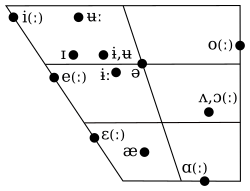Glenoe dialect
The Glenoe dialect is a dialect of Scots spoken in the Glenoe district in East Antrim, Northern Ireland.[1]
Phonology

Vowels of Glenoe Scots, from Gregg (1953)
| Front | Central | Back | |||
|---|---|---|---|---|---|
| unrounded | rounded | unrounded | rounded | ||
| Close | i | ɨ | ʉ | ||
| Close-mid | e | ə | o | ||
| Open-mid | ɛ | ʌ | ɔ | ||
| Open | æ | ɑ | |||
- Vowel length is not phonemic.[1]
- /i, e, ɛ/ are slightly lower than the corresponding cardinal vowels, but the difference is not very big.[1]
- /ɨ/, a phonologically central vowel, is further front and more open than cardinal [ɨ]: [ɨ̟˕]. Before /r/, it is lengthened and slightly lowered to [ɘ̟ː] (transcribed [ɨː] in this article).[1]
- /ʉ/, a phonologically central vowel, is further front than cardinal [ʉ]. The long allophone is almost fully close [ʉ̟ː], but the short allophone is somewhat lower: [ʉ̟˕].[1] For simplicity, these allophones are written [ʉː, ʉ] in this article.
- In addition to /i, ɨ, ʉ/, there is also a fourth close vowel [ɪ], which is non-phonemic. It appears as an allophone of /e/ in certain fused verb forms (e.g. 'hae tae' [ˈhɪtə] (have to), phonemically /ˈhetə/; cf. 'hae' [heː] (have), /he/)) as well as an allophone of /æ/ in unstressed syllables (in e.g. 'Polish' [ˈpɔːlɪʃ], /ˈpɔlæʃ/). Its phonetic quality is similar to that of /ɨ/ but more front. It is close to the KIT vowel (/ɪ/) in RP.[1]
- /ə/ is close-mid [ɘ].[1]
- /o/ is more strongly rounded and closer than the cardinal [o]: [o̹˔]. It is similar in quality to Swedish and Norwegian [u].[1]
- /ʌ, ɔ/ are near-back [ʌ̟, ɔ̟].[1]
- /æ/ is near-open near-front [æ̠], whereas /ɑ/ is open near-back [ɑ̟].[1]
- /æ/ corresponds to English /ɪ/, which in most English dialects is much closer [ɪ]. However, a similar sound of an [æ̠] quality is used by some speakers of Ulster English.[1]
References
Bibliography
- Gregg, Robert J. (1953). Smyth, Anne; Montgomery, Michael; Robinson, Philip (eds.). Phonology of an East Antrim Dialect. The Academic Study of Ulster Scots (Thesis).CS1 maint: ref=harv (link)
This article is issued from Wikipedia. The text is licensed under Creative Commons - Attribution - Sharealike. Additional terms may apply for the media files.